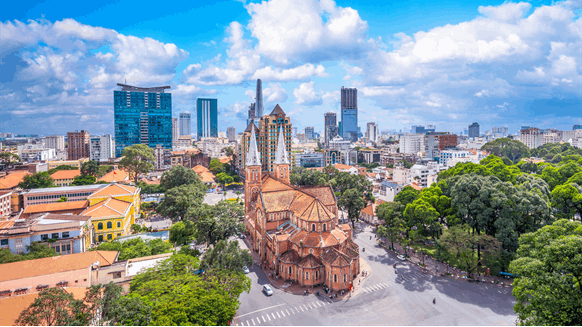
General Electric (GE) recently inked a memorandum of understanding (MoU) with Vietnamese electric utility Genco3, a subsidiary of EVN, Vietnam’s largest power company, to help develop a liquefied natural gas (LNG) power plant near Ho Chi Minh City.
The deal calls for GE to install the gas turbine technology and other equipment, while the company will also take an equity stake in the project. GE is following in the footsteps of numerous other companies, including those from the U.S., Japan and South Korea, that are investing in Vietnam’s fledgling LNG and LNG-to-power sector.
The need for foreign direct investment (FDI) in Vietnam’s energy sector, particularly its LNG-to-power sector, however, has a geopolitical root: stubborn interference from neighboring China.
Though Vietnam has ample offshore natural gas reserves, Beijing has forced state-run PetroVietnam and its partner Madrid-based Repsol to abandon nearly completed offshore gas production projects in Vietnam’s UN-mandated 200-nautical mile exclusive economic zone (EEZ) on two separate occasions since 2018. The most recent pullout reportedly cost Repsol around US$200 million in lost investment, a sum that that the company said it wanted Vietnam to reimburse.
China’s first intervention in Vietnam’s offshore exploration plans came in July 2017 when it forced partners in oil exploration block 136-03 to cease operations. Project partners included PetroVietnam, a Repsol subsidiary and Mubadala Development Co., a United Arab Emirates (UAE)-based company.
According to BBC reports at the time, Vietnam informed Repsol executives that “China had threatened to attack Vietnamese bases in the Spratly Islands (in the South China Sea) if the drilling did not stop.”
China, for its part, lays claim to a large swath of Vietnam’s EEZ in the hydrocarbon-rich South China Sea in a decades-long geopolitical dispute. China also claims around 90 percent of the South China Sea in what many refer to as the country’s U-shaped “nine-dash line,” marking the vast area on the map. Around one third of global maritime trade, nearly US$4 trillion, passes through the South China Sea each year – including vital oil and gas shipments to northeast Asia.
The Philippines, Taiwan, Indonesia, Malaysia and Brunei also have various overlapping South China Sea claims. South China Sea tensions have not only pitted rival claimants against each other, but also stoked tensions between Beijing and Washington. Washington as a result has increased navy freedom of navigation patrols near disputed areas to push back against what it sees as Chinese hegemony pursuits.
Tensions with China in the integral waterway have also led to improved bi-lateral relations between Washington and Hanoi, including former President Barack Obama’s approval of offensive military weapons sales after his visit to the country in 2016. It also includes the recent transfer of former U.S. Coast Guard cutters to Vietnam to help it patrol its territorial waters and increasing U.S. Navy port-of-call visits to the country.
Vietnam’s quandary
The quandary for Vietnam is that interference from Beijing comes as its GDP continues to grow (the second-highest in the region over the past 10 years), only lagging behind neighboring China, making new gas discoveries needed for power generation indispensable to sustain that growth trajectory. China is also Vietnam’s largest trading partner, representing 22.2 percent of the country’s total import and export volume, worth US$106.7 billion in 2019, according to Vietnamese government data.
Beijing and Hanoi also share political ideologies and are two of only five remaining communist governments in the world – further exacerbating the situation. Other communist states include Cuba, North Korea and Laos.
Vietnam’s inability to develop its own offshore hydrocarbon resources has led to a looming gas supply shortage, forecasted to begin as early as this year, with possible electricity brown and black outs in the country, particularly in the more populous southern region. However, due to economic contraction from the COVID-19 pandemic, the onset of that gas supply shortage has been extended at least until next year.
Even before the pandemic ends, however, more foreign energy companies are striking deals to invest in Vietnam’s LNG-to-power build-out. As many as 22 new LNG-to-power projects are to be included in the country’s new Power Development Plan (PDP) VIII 2021-2030, to be released early next year.
"gas" - Google News
December 14, 2020 at 04:24PM
https://ift.tt/3nh0kd3
Vietnam Gas Supply Crunch Hinges on Geopolitical Interference - Rigzone News
"gas" - Google News
https://ift.tt/2LxAFvS
https://ift.tt/3fcD5NP
Bagikan Berita Ini















0 Response to "Vietnam Gas Supply Crunch Hinges on Geopolitical Interference - Rigzone News"
Post a Comment